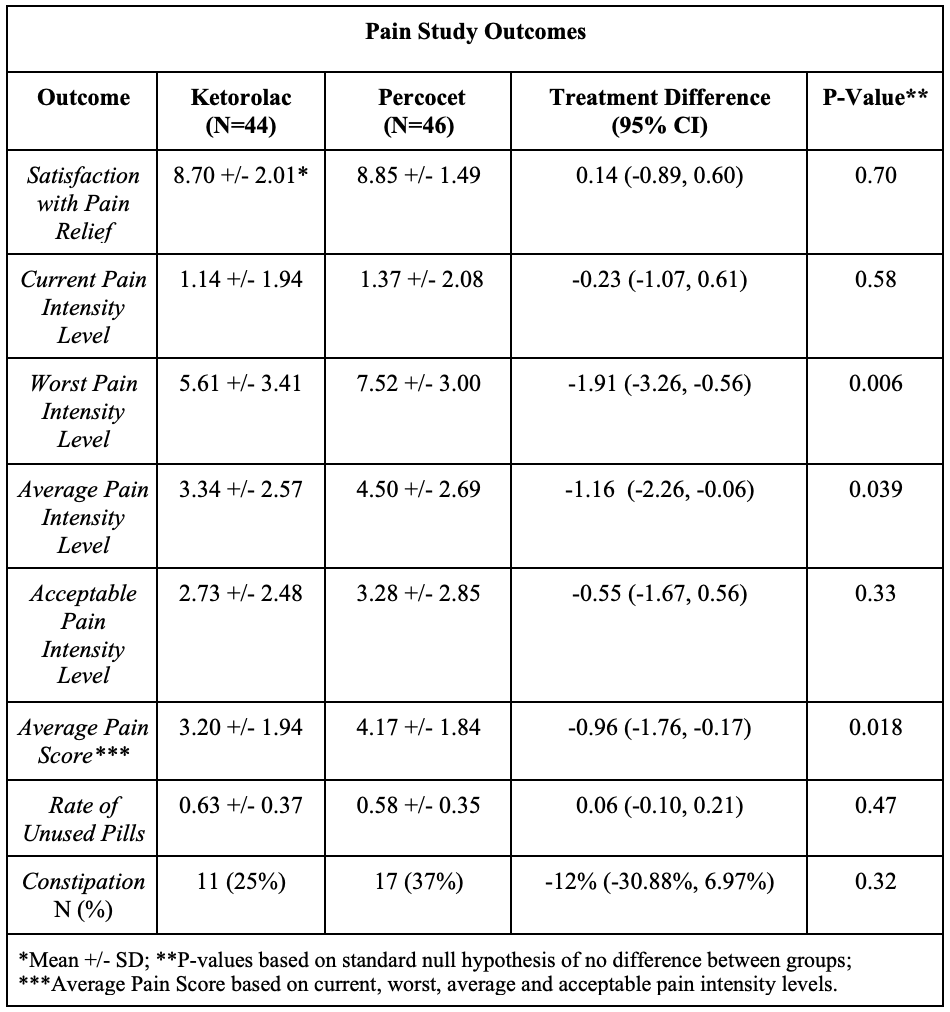Back
Poster, Podium & Video Sessions
Moderated Poster
MP31: Health Services Research: Quality Improvement & Patient Safety II
MP31-01: Minimizing Narcotics: A Randomized-Controlled Trial Comparing Percocet to Ketorolac After Kidney Stone Surgery
Saturday, May 14, 2022
2:45 PM – 4:00 PM
Location: Room 228
Mathew Demasi, Cleveland, OH, Michal Segall*, Nathan Feiertag, Amanda Mengotto, Pablo Cuartas, Justin Loloi, Bronx, NY, Jordan Ahn, Boston, MA, Josh Stern, Melissa Laudano, Kara Watts, Bronx, NY
- MS
Michal Segall, BS
Albert Einstein College of Medicine, Montefiore Medical Center
Poster Presenter(s)
Introduction: Opioids are often used for management of postoperative pain. Non-narcotic alternatives have increasingly been used in an effort to reduce opioid usage. We present the results from a randomized clinical trial comparing non-opioid therapy to opioid therapy after surgery for nephrolithiasis.
Methods: Patients undergoing elective ureteroscopy or percutaneous nephrolithotomy between July 2018-May 2021 were randomized to receive either Ketorolac (Group A) or Acetaminophen/Oxycodone (Group B). Each patient was surveyed by telephone one week post-operatively to assess pain outcomes using an 11-point ordinal rating scale questionnaire. Patient demographics, surgical variables, number of pills used, incidence of constipation, and any adverse events were also collected. A non-inferiority analysis was performed using the Mann-Whitney U-Test with a non-inferiority margin of 1.3 to compare pain ratings between both groups.
Results: A total of 90 patients had complete data; 44 (49%) in group A and 46 (51%) in group B. Both groups were similar in terms of demographics, type of stone removal surgery, whether or not a stent was placed, and stone burden. At one week follow up, overall reported pain scores were similar between both groups, demonstrating non-inferiority of group A compared to group B (Table 1). Group A experienced significantly lower average pain scores (? = -0.96; [-1.76, -0.17], p = 0.018) and worst pain intensity level scores (? = -1.91; [-3.26, -0.56], p = 0.006). There was no significant difference in rates of unused pills (Ketorolac: 0.63 ± 0.37, Percocet: 0.58 ± 0.35; p = 0.47) and constipation (Ketorolac: 11[25%], Percocet: 17 [37%]; p = 0.32) between groups.
Conclusions: Pain outcomes with non-opioid analgesia (Ketorolac) are non-inferior to opioid analgesia (acetaminophen/oxycodone) after kidney stone surgery. This trial contributes to the increasing evidence that non-opioid analgesics, like Ketorolac, should be considered an effective option for pain management following non-invasive urologic procedures.
Source of Funding: None.

Methods: Patients undergoing elective ureteroscopy or percutaneous nephrolithotomy between July 2018-May 2021 were randomized to receive either Ketorolac (Group A) or Acetaminophen/Oxycodone (Group B). Each patient was surveyed by telephone one week post-operatively to assess pain outcomes using an 11-point ordinal rating scale questionnaire. Patient demographics, surgical variables, number of pills used, incidence of constipation, and any adverse events were also collected. A non-inferiority analysis was performed using the Mann-Whitney U-Test with a non-inferiority margin of 1.3 to compare pain ratings between both groups.
Results: A total of 90 patients had complete data; 44 (49%) in group A and 46 (51%) in group B. Both groups were similar in terms of demographics, type of stone removal surgery, whether or not a stent was placed, and stone burden. At one week follow up, overall reported pain scores were similar between both groups, demonstrating non-inferiority of group A compared to group B (Table 1). Group A experienced significantly lower average pain scores (? = -0.96; [-1.76, -0.17], p = 0.018) and worst pain intensity level scores (? = -1.91; [-3.26, -0.56], p = 0.006). There was no significant difference in rates of unused pills (Ketorolac: 0.63 ± 0.37, Percocet: 0.58 ± 0.35; p = 0.47) and constipation (Ketorolac: 11[25%], Percocet: 17 [37%]; p = 0.32) between groups.
Conclusions: Pain outcomes with non-opioid analgesia (Ketorolac) are non-inferior to opioid analgesia (acetaminophen/oxycodone) after kidney stone surgery. This trial contributes to the increasing evidence that non-opioid analgesics, like Ketorolac, should be considered an effective option for pain management following non-invasive urologic procedures.
Source of Funding: None.


.jpg)
.jpg)